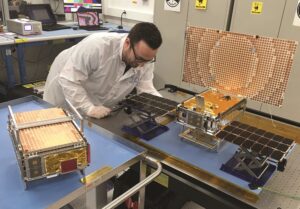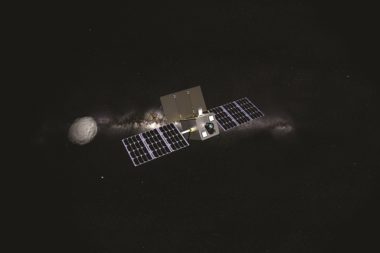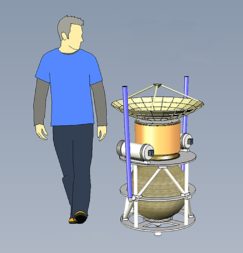MarCO shows interplanetary cubesats possible but not easy
By Caleb Henry

NASA’s Jet Propulsion Laboratory knew flying cubesats all the way to Mars was a long shot. Its twin Mars Cube One spacecraft had to travel hundreds of millions of kilometers on their own propulsion and relay data from the agency’s Insight lander as it descended onto the Red Planet.
During that nearly seven-month journey in 2018, one of the MarCO cubesats suffered a fuel leak, and both briefly lost contact when the glow of nearby Mars blinded their star trackers, causing a loss of spacecraft orientation until the trackers could see stars again.
“MarCO had a number of challenges along the way,” Andrew Klesh, JPL’s chief engineer for the MarCO cubesats, told SpaceNews.
JPL overcame those challenges, completing MarCO’s main mission objective Nov. 26, 2018, by providing a real-time communications link back to Earth as the $1 billion Insight lander touched down on Mars. In the process, the $18.5 million MarCO mission proved that cubesats could support science around other worlds. Klesh said the agency used sunlight bouncing off MarCO-B’s solar panels and antenna to help steer the leaky satellite to Mars using less fuel. As they flew by Mars, the cubesats completed a secondary goal of photographing the planet — capturing a photo that would encourage others to design their own cubesats for deep space missions.
“The most exciting thing about MarCO is that it has inspired so many missions around the world,” Klesh said. “I really wouldn’t be able to give you a number.”
The MarCO spacecraft remained in touch with NASA several weeks beyond Insight’s landing. A follow-up campaign to reestablish contact was unsuccessful, prompting NASA to formally end the mission early this year.
JPL is now working with partners on several other cubesat missions to explore the solar system using lessons learned from MarCO, Klesh said. Among them:
- Lunar Trailblazer, a California Institute of Technology-led mission to map water on the moon;
- LunaH-Map, a hydrogen mapper being built by the University of Arizona; and
- Near Earth Asteroid Scout, a mission JPL is developing with NASA’s Marshall Space Flight Center.
Low cost, not low effort
Cubesats have the advantage of being cheaper to build than traditional larger science spacecraft. But cubesats designed for deep space require more durable components than their commercial counterparts in low Earth orbit.
Klesh said JPL had to develop a new radio transponder for MarCO, as well as a deployable high-gain reflector array. JPL also had to modify commercial components before including them on the MarCO mission. That work included creating larger propulsion tanks with Vacco Industries, an attitude determination and control system with Blue Canyon Technologies that functioned beyond the reach of GPS, and designing a flight computer with AstroDev and the University of Michigan that would work in deep space, he said.

The European Space Agency is now working to apply lessons it learned from NASA’s MarCO cubesats to its own deep space cubesat missions, said Roger Walker, ESA’s cubesat technology manager.
“It’s been a real trailblazer for the cubesat community around the world and also in Europe,” he said of MarCO. “The lessons we’ve drawn from that are many.”
ESA has five deep space cubesats in development — three for asteroids and two for the moon. Each has a budget within the range of $10 million to $20 million, Walker said. ESA is studying potential Mars cubesat missions, he said, but only at a preliminary level.
One area ESA is trying to address is costs stemming from spacecraft operations, since those don’t change much with spacecraft size, he said. M-ARGO, ESA’s Miniaturised Asteroid Remote Geophysical Observer cubesat projected to launch between 2023 and 2025, will feature an autonomous navigation experiment that uses the spacecraft’s optical sensors to triangulate its position by observing planets, Walker said.
“It will enable us to rely less on tracking of the spacecraft with ground stations on Earth to determine position,” he said. “The lower cost level is also enabling us to take higher risks and do more innovative things which, if proven on cubesat missions, will then lower the costs for larger missions as well in terms of operations.”
M-ARGO is arguably ESA’s most technologically demanding cubesat exploration mission, Walker said. ESA, with partners Gomspace in Luxembourg and the Polytechnic University of Milan in Italy, is developing the satellite, which Walker said will need high-power electric propulsion and high-power communications systems to look for water and other resources on an asteroid.
From Martian flybys to orbits
Researchers in Europe and the United States interested in Mars-bound cubesat missions say a key challenge for building on MarCO’s success is to not just fly past Mars with cubesats, but to enter orbit and conduct science.
Polytechnic University of Milan, in addition to its work on M-ARGO, is designing a 16-unit cubesat called MARIO, short for Mars Atmospheric Radiation Imaging Orbiter, that would study the thermal environment of Mars’ upper atmosphere during a six-toeight month mission.
MARIO is not a funded mission, but one the university hopes will gain ESA support.
Karthik Venkatesh Mani, MARIO’s project manager, said the cubesat would be used to demonstrate a “ballistic capture” into areostationary orbit — the Mars equivalent of Earth’s geostationary orbit.

MARIO would first launch as a rideshare on a commercial mission to a geostationary transfer orbit with an apogee around 90,000 kilometers, then execute an orchestrated mix of chemical- and electric-propulsive maneuvers to reach Mars in about four years time, he said.
“The scientific aspect is not so profound, I have to say, but it has an immense value because if we are able to perform thermal radiation imaging — which is essentially performed by multiple Mars missions — but with such a small spacecraft, and investing possibly $30 million, we achieve a very high science to investment ratio,” Mani said. “This is what we want to achieve.”
The idea of a cubesat not only reaching Mars but then entering orbit solely on its own propulsion is not without its critics, though.
“Right now there’s no prayer for cubesats to get on their own in orbit around Mars,” said Jaime Esper, a senior engineer at NASA’s Goddard Space Flight Center. “By the time you end up adding the fuel that’s required to get you into Mars orbit insertion, your cubesat is no longer going to be a cubesat; it’s going to be a smallsat.”
Esper co-authored a paper with Apollo 11 astronaut Buzz Aldrin on a potential vehicle called the Spacecraft Human Exploration Resource Prospector with Aero-braking, or SHERPA, that could act as a mothership to bring an entire fleet of cubesats to Mars.
“If you were to instead mount a series of cubesats onto the back of a decelerator aeroshell, that allows you to actually do aerocapture on Mars,” he said. “Now you’re enabling the ability to send these spacecraft into Mars orbit.”
Like MARIO, Esper and Aldrin’s SHERPA is an idea in search of funding. Esper said SHERPA, if flown, would likely require a fraction of what NASA allocates for its Discovery class of solar system exploration missions, which in recent years have had a budget cap of $500 million, excluding launch and operations.
This article originally appeared in the July 13, 2020 issue of SpaceNews magazine.
August 5, 2020 at 07:51PM
via SpaceNews read more...

Post a Comment